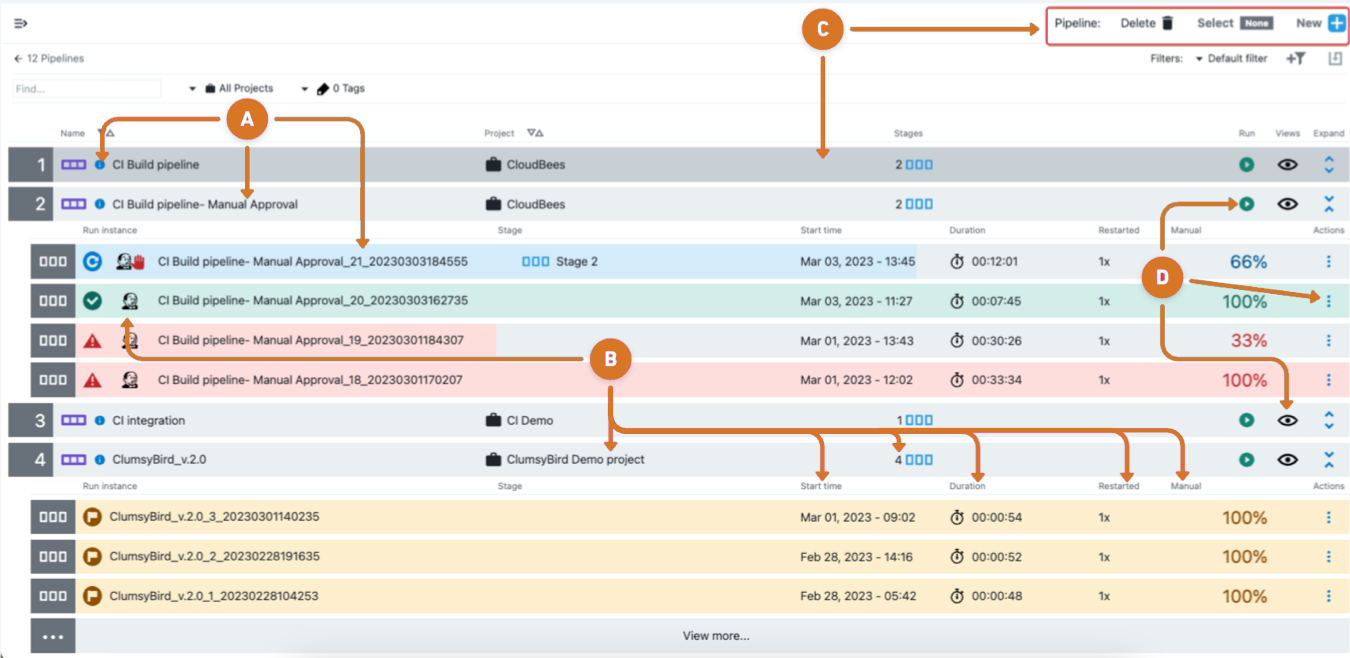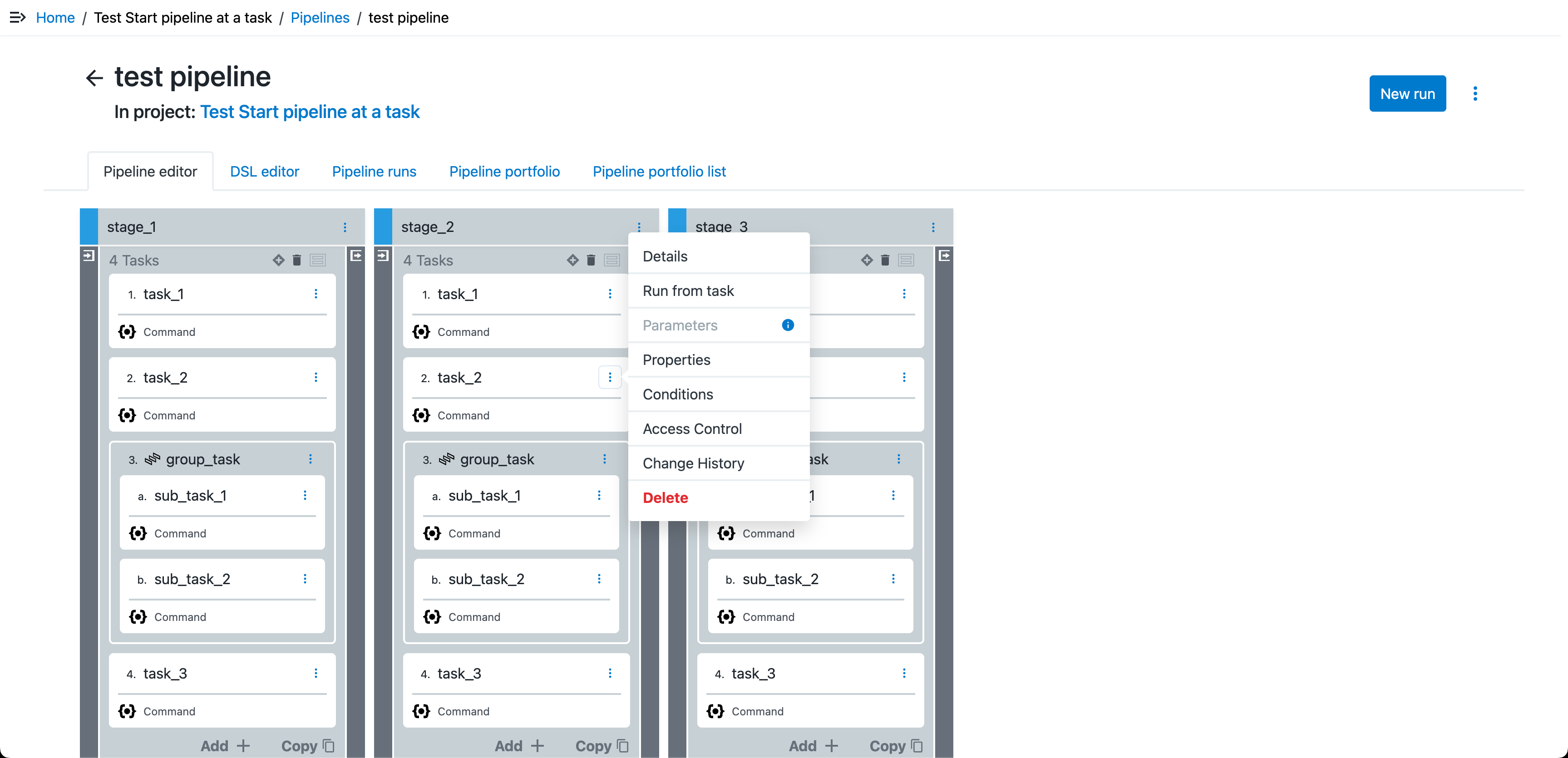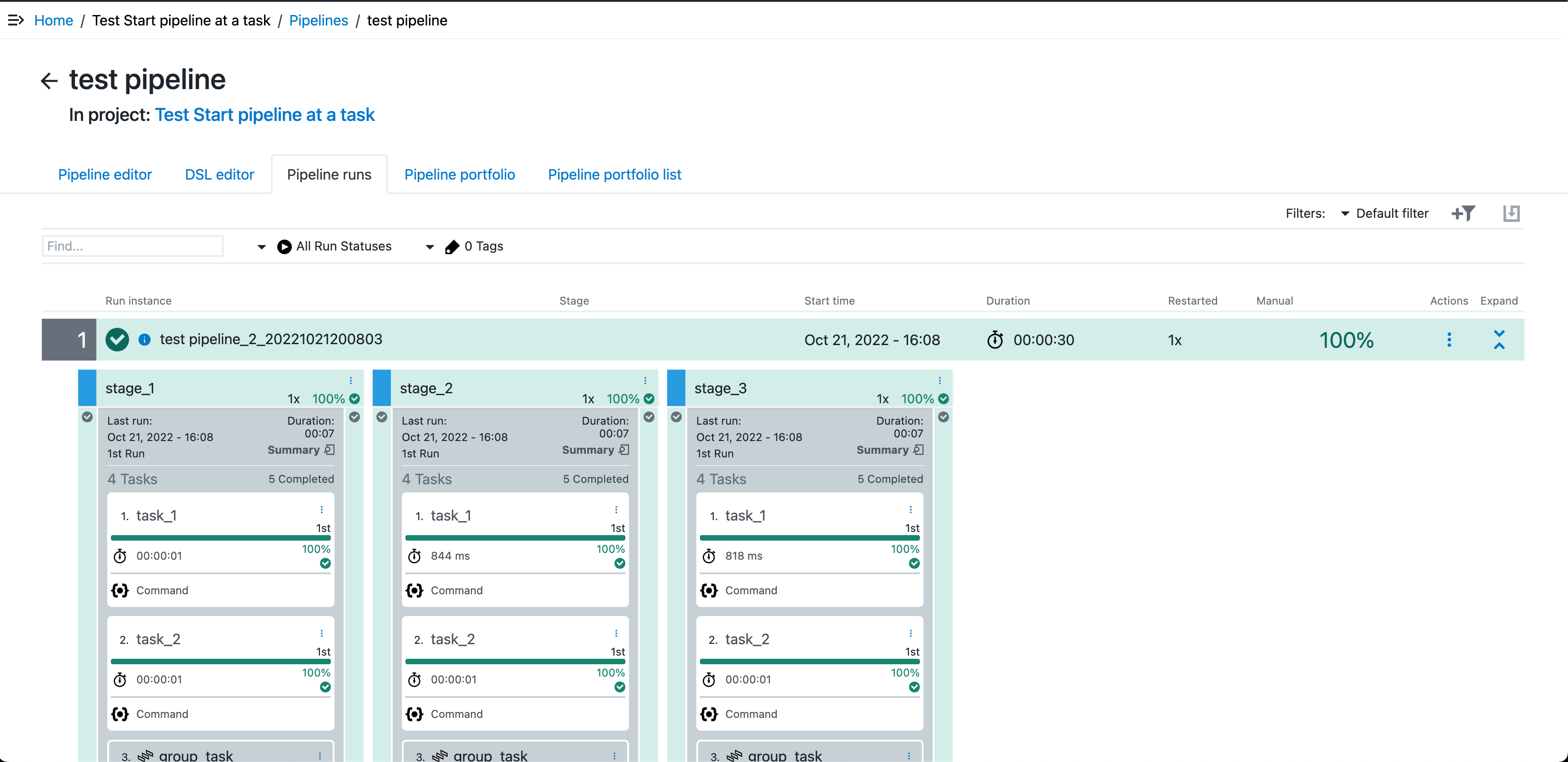This section shows how pipelines are represented in the CloudBees CD/RO UI.
Pipelines List
The Pipelines List shows all the pipelines that you have permission to view. Access CloudBees CD/RO Pipeline list by navigating to .

-
Access pipeline and pipeline run data.
-
Modify pipeline description and tags by selecting the
 information icon.
information icon. -
Edit the pipeline by selecting the pipeline name link.
-
Modify the pipeline run by selecting the Run instance name link.
-
-
Manage run instances.
-
Access pipeline CloudBees CI build data by selecting the
 CloudBees CI view build data icon.
CloudBees CI view build data icon. -
Chose to proceed or abort a CloudBees CI pipeline task by selecting the
 CloudBees CI pipeline approval icon.
CloudBees CI pipeline approval icon. -
Review pipeline run data in the Project, Stage, Start time, Duration, and Restarted columns.
-
-
Add or remove pipelines.
-
Create a new or copy an existing pipeline by selecting
 new icon.
new icon. -
Remove a pipeline.
-
Select the pipeline to be deleted.
-
Select the
 delete icon.
delete icon.
-
-
Deselect chosen pipelines by selecting the
 Select none icon.
Select none icon.
-
-
Manage pipelines.
-
Run the pipeline by selecting the
 view icon.
view icon. -
Select the
 view icon to navigate to one of the following pipeline features.
view icon to navigate to one of the following pipeline features.-
Pipeline editor
-
Pipeline run
-
DSL editor
-
Pipeline portfolio
-
Pipeline portfolio list
-
-
Pipeline Editor
Use the pipeline editor to configure pipeline attributes. Access the CloudBees CD/RO Pipeline editor one of following ways:
-
Navigate to . Then select the pipeline
namelink. -
Navigate to . Then select the pipeline run instance
namelink.

-
Access pipeline data.
-
Select the
 folder icon to access the full parent to child path.
folder icon to access the full parent to child path. -
Select the navigation links to access applicable associated project, release or service account.
-
Navigate between pipeline management features by selecting one of the following tabs:
-
DSL editor
-
Pipeline runs
-
Pipeline portfolio
-
Pipeline portfolio list
-
-
-
Manage pipeline attributes.
-
Run the pipeline by selecting New run.
-
Configure pipeline by selecting the pipeline
 3-dots and a configuration option.
3-dots and a configuration option.Click to view options.
-
Pipeline details: opens the Edit Pipeline dialog box where you can edit pipeline details.
-
Schedules: opens pipeline scheduler which allows you to set a time for future pipeline runs.
-
Triggers: opens trigger configuration which allows you to configure pipeline triggers.
-
DSL Export: select to download DSL corresponding to the current object.
-
Parameters: opens the Parameters dialog box where you can view, add, and delete the parameters attached to the pipeline.
-
Properties: opens the Properties screen. You can view, add, and delete the properties associated with the pipeline. Refer to Configuring properties or property sheets for more information.
-
Access Control: opens the Access Control page where you can view, add, and edit the privileges for the pipeline.
-
Change History: shows the Change History for the pipeline and the objects in it. CloudBees CD/RO tracks the changes to tracked objects including applications and microservices, procedures, workflows, workspaces, resources, and project-owned components.
-
Previous run: open listing of previous pipeline runs.
-
Delete: deletes the pipeline.
-
-
Create new stage by selecting
 .
. -
Configure a stage by selecting the stage
 3-dots and a configuration option.
3-dots and a configuration option.Click to view options.
-
Details: Use to a modify task details.
-
Add task: Use to a create a new task.
-
Copy task: Create a copy of the selected task.
-
Run from stage: Start pipeline run from selected stage.
-
Duplicate: Clones the entire stage.
-
Re-order: After
-
Re-order: Before
-
Properties: opens the Property list Refer to: Configuring properties or property sheets for more information.
-
Conditions: select to view or set “run if” and “wait until” conditions and pipeline or release wait dependencies for this stage.
-
Access control: opens the Access Control page where you can view, add, and edit the privileges for the stage.
-
Change history: Displays the Change History for the stage.
-
Delete: Deletes the stage.
-
-
Modify a task by selecting the task
 3-dots and a configuration option.
3-dots and a configuration option.Click to view options.
-
Details: Use to modify task details.
-
Run from task: Use to start the pipeline from the selected task.
-
Parameters: opens the Parameters dialog box where you can view, add, and delete the parameters attached to the task.
-
Properties: opens the Properties screen. You can view, add, and delete the properties associated with the task. Refer to Configuring properties or property sheets for more information.
-
Conditions: select to view or set “run if” and “wait until” conditions and pipeline or release wait dependencies for this task.
-
Access control: opens the Access Control page where you can view, add, and edit the privileges for the task.
-
Change history: Change History : Displays the Change History for the task.
-
Delete: Deletes the task.
-
-
-
Manage stage components.
-
Modify entry or exit gate settings. Entry and exit gates contain the rules for moving between pipeline stages. If a gate contains rules, it is gray and expandable. Select the gate to modify the rules. When there are no rules the gate is white and not expandable. Select the plus icon to add rules. For more information, refer to Entry and Exit Gates.
-
Create a new pipeline task by selecting

-
Duplicate a pipeline task by selecting

-
Modify task attributes by selecting the task name or task type link.
-
Creating and managing tasks
To create a task, select Add Task or Copy, then follow the prompts.
-
Enter a name for the task.
-
Click Select Task Type. The Task Type dialog box displays.
-
Native —List of standard task types such as Command or Application Process.
-
Plugins —The top ten plugins followed by the rest of the list. The ec_preferred_integrations property sheet determines the plugins to appear in this list and their order. For more information about property sheets, refer to Properties .
-
Frequently used plugins — The list of up to ten frequently used pipeline plugins. The ec_frequently_used_pipeline_plugins property sheet determines the plugins to appear in this list and their order.
-
It is populated by local plugin usage statistics collected by a watch dog thread run every five days. To change the watch dog schedule modify the Default background plugin statistics thread schedule server property via Settings on the Administration > Serve r page.
-
To manually modify this list, open the Automation Platform at https://<cloudbees-flow-server>/flow/, then select Administration > Server > ec_deploy > ec_frequently_used_pipeline_plugins, and then edit the list.
-
-
The rest of the list—to edit the list open the Automation Platform at https://<cloudbees-flow-server>/flow/and select Administration > Server > ec_deploy > ec_preferred_integrations t.
Select the task type. The dialog box closes, and the task now displays the selected task type.
-
-
Select Define. Add details for this task’s type. Subsequent dialog varies based on task type.
-
If you want to add another task, select Add + and repeat the previous steps to add it. The resulting task list shows the tasks in the order that they will be executed.
Starting a pipeline run from tasks or stages
With the required privileges, you can start a pipeline run from a single task, group tasks, or a stage.
The task from which you start the pipeline run must have a status of not-run.
When you start a pipeline run from a task, the pipeline has a warning status and message in the stage summary.
Restarting a stage with from a task restarts the run from the starting task. Any tasks that have not completed will not run.
You cannot start a pipeline run from a gated task, a subtask that is part of a group, or start from a task with startingStage specified in the run command.
|
To start a pipeline run from a single task:
-
Select the three vertical dots, then select Run from task.
 Figure 3. Run a pipeline from a task
Figure 3. Run a pipeline from a task -
Enter your run details.
-
Select Run.
To start a pipeline run from a group tasks:
-
Select the three vertical dots, then select Run from group.
-
Enter your run details.
-
Select Run.
| You cannot start a pipeline run from a group subtask. |
To start a pipeline run from a stage:
-
Select the three vertical dots, then select Run from stage.
-
Enter your run details.
DSL example
Click to view DSL example
// data variables def projName = 'Test Start pipeline at a task' def pipelineName = 'test pipeline' def stageNames = [s1: 'stage_1', s2: 'stage_2', s3: 'stage_3'] def taskNames = [t1 : 'task_1', t2 : 'task_2', t3 : 'task_3', subTask1: 'sub_task_1', subTask2: 'sub_task_2', group : 'group_task', gt1 : 'gate_task_1', gt2 : 'gate_task_2'] def gateConditionValue = '''/* Sample code to set the evidence on the task and pass the condition */ $[/javascript setProperty("/myTaskRuntime/evidence", "test value") true; ]''' // pipeline structure project projName, { pipeline pipelineName, { stage stageNames.s1, { gate 'PRE', { task taskNames.gt1, { gateType = 'PRE' gateCondition = gateConditionValue taskType = 'CONDITIONAL' } } gate 'POST', { task taskNames.gt2, { gateType = 'POST' gateCondition = gateConditionValue taskType = 'CONDITIONAL' } } task taskNames.t1, { actualParameter = [ 'commandToRun': 'echo success', ] subpluginKey = 'EC-Core' subprocedure = 'RunCommand' taskType = 'COMMAND' } task taskNames.t2, { actualParameter = [ 'commandToRun': 'echo success', ] subpluginKey = 'EC-Core' subprocedure = 'RunCommand' taskType = 'COMMAND' } task taskNames.group, { subproject = 'Default' taskType = 'GROUP' task taskNames.subTask1, { groupName = taskNames.group actualParameter = [ 'commandToRun': 'echo success', ] subpluginKey = 'EC-Core' subprocedure = 'RunCommand' taskType = 'COMMAND' } task taskNames.subTask2, { groupName = taskNames.group actualParameter = [ 'commandToRun': 'echo success', ] subpluginKey = 'EC-Core' subprocedure = 'RunCommand' taskType = 'COMMAND' } } task taskNames.t3, { actualParameter = [ 'commandToRun': 'echo success', ] subpluginKey = 'EC-Core' subprocedure = 'RunCommand' taskType = 'COMMAND' } } stage stageNames.s2, { gate 'PRE', { task taskNames.gt1, { gateCondition = gateConditionValue gateType = 'PRE' taskType = 'CONDITIONAL' } } gate 'POST', { task taskNames.gt2, { gateType = 'POST' gateCondition = gateConditionValue taskType = 'CONDITIONAL' } } task taskNames.t1, { actualParameter = [ 'commandToRun': 'echo success', ] subpluginKey = 'EC-Core' subprocedure = 'RunCommand' taskType = 'COMMAND' } task taskNames.t2, { actualParameter = [ 'commandToRun': 'echo success', ] subpluginKey = 'EC-Core' subprocedure = 'RunCommand' taskType = 'COMMAND' } task taskNames.group, { subproject = 'Default' taskType = 'GROUP' task taskNames.subTask1, { groupName = taskNames.group actualParameter = [ 'commandToRun': 'echo success', ] subpluginKey = 'EC-Core' subprocedure = 'RunCommand' taskType = 'COMMAND' } task taskNames.subTask2, { groupName = taskNames.group actualParameter = [ 'commandToRun': 'echo success', ] subpluginKey = 'EC-Core' subprocedure = 'RunCommand' taskType = 'COMMAND' } } task taskNames.t3, { actualParameter = [ 'commandToRun': 'echo success', ] subpluginKey = 'EC-Core' subprocedure = 'RunCommand' taskType = 'COMMAND' } } stage stageNames.s3, { gate 'PRE', { task taskNames.gt1, { gateCondition = gateConditionValue gateType = 'PRE' taskType = 'CONDITIONAL' } } gate 'POST', { task taskNames.gt2, { gateCondition = gateConditionValue gateType = 'POST' taskType = 'CONDITIONAL' } } task taskNames.t1, { actualParameter = [ 'commandToRun': 'echo success', ] subpluginKey = 'EC-Core' subprocedure = 'RunCommand' taskType = 'COMMAND' } task taskNames.t2, { actualParameter = [ 'commandToRun': 'echo success', ] subpluginKey = 'EC-Core' subprocedure = 'RunCommand' taskType = 'COMMAND' } task taskNames.group, { subproject = 'Default' taskType = 'GROUP' task taskNames.subTask1, { groupName = taskNames.group actualParameter = [ 'commandToRun': 'echo success', ] subpluginKey = 'EC-Core' subprocedure = 'RunCommand' taskType = 'COMMAND' } task taskNames.subTask2, { groupName = taskNames.group actualParameter = [ 'commandToRun': 'echo success', ] subpluginKey = 'EC-Core' subprocedure = 'RunCommand' taskType = 'COMMAND' } } task taskNames.t3, { actualParameter = [ 'commandToRun': 'echo success', ] subpluginKey = 'EC-Core' subprocedure = 'RunCommand' taskType = 'COMMAND' } } } } // start pipeline at a task runPipeline projectName: projName, pipelineName: pipelineName, startingTaskStage: stageNames.s2, startingTask: taskNames.t2 -
Select Run.
 Figure 4. Run result
Figure 4. Run result
The resulting dialog varies based on the action menu selection and the task type.
Pipeline runs
The Pipeline runs screen displays a listing of all pipelines that have been run. Access the Pipeline runs screen one of the following ways:
-
From the Release editor or Pipeline editor select the Pipeline runs tab.
-
Navigate to . Then select the pipeline
namelink.

-
Manage pipeline run instances.
-
Manage CloudBees CI pipeline tasks.
-
Choose to proceed or abort a pipeline run instance task by selecting
 CloudBees CI approval icon.
CloudBees CI approval icon. -
Review CloudBees CI build data for a run instance by selecting the
 CloudBees CI build data icon.
CloudBees CI build data icon.
-
-
Edit the pipeline run instances by selecting the instance name link.
-
Modify a run instance stage by selecting
 3-dots and a configuration option.
3-dots and a configuration option.Click to view options.
-
Restart: Use to restart the stage.
-
Properties: opens the Properties screen. You can view, add, and delete the properties associated with the stage. Refer to: Configuring properties or property sheets for more information.
-
Access control: opens the Access Control page where you can view, add, and edit the privileges for the stage.
-
-
-
Configure run instance pipeline task.
-
Modify task properties by selecting
 3-dots and a configuration option.
3-dots and a configuration option.Click to view options
-
Properties: opens the Properties screen. You can view, add, and delete the properties associated with the task. Refer to: Configuring properties or property sheets for more information.
-
Parameters: opens the Parameters dialog box where you can view, add, and delete the parameters attached to the task.
-
View previous runs: opens the Parameters dialog box where you can view, add, and delete the parameters attached to the task.
-
Access control: opens the Access Control page where you can view, add, and edit the privileges for the task.
-
-
-
Remove pipeline run instances.
-
Delete pipeline run instances.
-
Select the pipelines to be removed.
-
Select the
 delete icon or Delete pipeline runs
delete icon or Delete pipeline runs
-
-
Deselect chosen run instances by selecting the
 select none icon.
select none icon.
-
-
Manage run instances.
-
Review pipeline run instance data in the Stage, Start time, Duration, and Restarted columns.
-
Modify a run instance pipeline by selecting
 3-dots and a configuration option.
3-dots and a configuration option.Click to view options.
-
Run again: Restarts the pipeline.
-
Restart from failure: Restarts the pipeline from execution failure.
-
Properties: opens the Properties screen. You can view, add, and delete the properties associated with the pipeline. Refer to: Configuring properties or property sheets for more information.
-
Parameters: opens the Parameters dialog box where you can view, add, and delete the parameters attached to the pipeline.
-
Access control: opens the Access Control page where you can view, add, and edit the privileges for the pipeline.
-
Change history: Displays the Change History for the pipline.
-
Audit reports: Displays the Audit and compliance reports for the pipeline.
-
Delete: Deletes the pipeline.
-
-